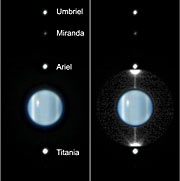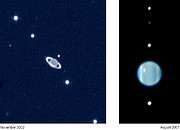Press Release
Edge-On!
Peering at Uranus's Rings as they Swing Edge-on to Earth for the First Time Since their Discovery in 1977
23 August 2007
As Uranus coasts through a brief window of time when its rings are edge-on to Earth - a view of the planet we get only once every 42 years - astronomers peering at the rings with ESO's Very Large Telescope and other space or ground-based telescopes are getting an unprecedented view of the fine dust in the system, free from the glare of the bright rocky rings. They may even find a new moon or two.
"ESO's VLT took data at the precise moment when the rings were edge-on to Earth," said Imke de Pater, of University of California, Berkeley who coordinated the worldwide campaign. She worked with two team members observing in Chile: Daphne Stam of the Technical University Delft in the Netherlands and Markus Hartung of ESO.
The observations were done with NACO, one of the adaptive optics instruments installed at the VLT. With adaptive optics, it is possible to obtain images almost free from the blurring effect of the atmosphere. It is as if the 8.2-m telescope were observing from space.
Observations were also done with the Keck telescope in Hawaii, the Hubble Space Telescope, and at the Palomar Observatory.
"Using different telescopes around the world allows us to observe as much of the changes during the ring-plane crossing as possible: when Uranus sets as seen from the VLT, it can still be observed by the Keck," emphasised Stam.
Uranus orbits the Sun in 84 years. Twice during a Uranian year, the rings appear edge-on to Earth for a brief period. The rings were discovered in 1977, so this is the first time for a Uranus ring-crossing to be observed from Earth.
The advantage of observations at a ring-plane crossing is that it becomes possible to look at the rings from the shadowed or dark side. From that vantage point, the normally bright outer rings grow fainter because their centimetre- to metre-sized rocks obscure one another, while the dim inner rings get brighter as their material merges into a thin band along the line of sight.
Two little satellites called Cordelia and Ophelia straddle the brightest ring, the 'Epsilon Ring', and keep it in place, but it has always been assumed there must be more of these satellites that are confining the 9 other narrow rings. Normally the satellites are lost in the glare of the rings, but during these events the unique orientation makes the bright rings essentially invisible. Thus the ring plane crossing gives astronomers a rare chance, just once every 42 years, to image these tiny satellites.
Imke de Pater and colleagues made observations of the rings with the Keck II telescope on 28 May 2007. These observations are presented in an article appearing today (Thursday 23 August) in Science Express, the online edition of Science magazine. There, the astronomers report that the rings of micron-sized dust have changed significantly since the Voyager 2 spacecraft photographed the Uranus system 21 years ago. Imke de Pater will discuss these results and the new images during a talk today at the European Planetary Science Congress 2007 meeting in Potsdam, Germany.
Notes
Earth's orbit around the Sun permits three opportunities to view the rings edge-on during each ring-plane crossing: Uranus made its first ring crossing as seen from Earth on May 3, it made its second crossing on Aug. 16, and will cross for the third time on Feb 20, 2008. Though the last ring crossing relative to Earth will be hidden behind the Sun, most of Earth's premier telescopes, including the VLT, Keck, Hubble, and Palomar, plan to focus on the planet again in the days following December 7, 2007. December 7 is the Uranian equinox, when the rings are perfectly edge-on to the Sun, and after that there is a brief period again when one will view the dark side of the rings, before they become illuminated again for another 42 years.
Contacts
Imke de Pater
University of California
Berkeley, USA
Email: imke@berkeley.edu
Daphne Stam
Technical University Delft
Delft, Netherlands
Tel: +31 30 253 5722
Email: D.M.Stam@sron.nl
Markus Hartung
ESO
Chile
Email: mhartung@eso.org
About the Release
| Release No.: | eso0737 |
| Legacy ID: | PR 37/07 |
| Name: | Uranus |
| Type: | Solar System : Planet : Satellite Solar System : Planet : Ring |
| Facility: | Very Large Telescope |
| Instruments: | NACO |


